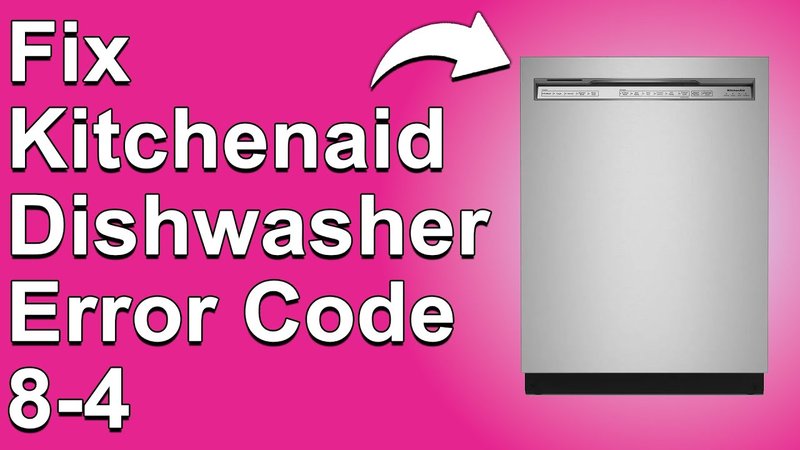
Error codes can be puzzling, especially when you’re not familiar with them. The E2 error code is a common alert on KitchenAid dishwashers. While it might seem daunting at first, it’s actually the dishwasher’s way of communicating a specific problem. Think of it as a distress signal from your appliance, saying, “Hey, I need a little help here!” Understanding what this code means is the first step toward getting your dishwasher back in working order.
Understanding What Error Code E2 Means
When you see the error code E2 on your KitchenAid dishwasher, it generally indicates a problem with the machine’s ability to drain water. Essentially, it’s like when you’re trying to empty a bathtub, but the drain is clogged and water isn’t flowing out as it should. This code tells you that the dishwasher has detected an issue stopping it from draining correctly. It’s a critical alert because without proper drainage, your dishwasher can’t run its cycles effectively.
The core of the issue usually lies in some obstruction or malfunction within the drainage system. Maybe something is blocking the drain, or perhaps a component isn’t working as intended. Just like how a blocked sink needs unclogging, your dishwasher might require some attention to get things moving again. You might wonder, “Can I fix this myself?” The good news is that with a bit of understanding and patience, you often can!
Sometimes, the E2 error can also be triggered by electronic glitches, where the control board isn’t sending or receiving signals correctly. Imagine if the brain of your dishwasher got its wires crossed—literally and figuratively. While this sounds technical, understanding and addressing these causes can often clear up the problem.
Common Causes of Error Code E2
So, what’s causing this pesky E2 error? The most common culprit is a clogged drain. Food particles, soap scum, and even small utensils that accidentally slip through can create a blockage. Think of it like trying to drink through a straw that’s got a chunk of ice stuck in it—nothing’s going to pass through smoothly. Regularly cleaning the filter and the area around the drain can prevent this buildup.
Another potential cause could be a malfunctioning drain pump. The drain pump is like the heart of the dishwasher’s drainage system, helping push the water out. If it’s not working properly, everything backs up. Just like how a car engine fails when a critical part breaks, your dishwasher can’t perform if the pump is faulty. Troubleshooting the pump involves checking if the pump motor is running or if it’s jammed by debris.
Sometimes, the issue could also stem from a kinked or improperly installed drain hose. If the hose is pinched or twisted, water can’t flow through it. Imagine trying to pour water through a bent tube—it just doesn’t work efficiently. Ensuring the hose is straight and properly connected can often resolve this.
Steps to Resolve the E2 Error Code
First things first: always unplug your dishwasher or turn off the power before inspecting or working on it. Safety is paramount! Once that’s done, start by examining and cleaning the dishwasher’s filter and drain area. Often, this simple step can remove blockages and fix the problem. You might be surprised at what you find—a rogue piece of silverware or a mushy mass of leftover food particles.
Next, check the drain pump. Listen for noise when the pump tries to run. If it’s silent or making a troubling sound, it might need attention. You can often find guides online or in your dishwasher’s manual to help you inspect and, if necessary, replace the pump.
Finally, inspect the drain hose. Ensure it’s not twisted or kinked and that it’s properly attached. Sometimes, repositioning the hose can be all it takes to solve the problem. If you’ve gone through these steps and the error persists, it might be time to call a professional. They can diagnose more complex issues that you might not be able to handle alone.
Preventing Future Error Code E2 Incidents
Now that you’ve tackled the E2 error, let’s talk prevention. Just like regular oil changes keep your car running smoothly, routine maintenance can keep your dishwasher in tip-top shape. Regularly clean the filter and check for debris in the drain. This can prevent clogs and keep everything flowing as it should. Think of it as giving your dishwasher an occasional health check-up.
If you frequently find foreign objects in the dishwasher’s drain, consider using a mesh filter insert. These are great at catching small bits and pieces that might otherwise end up where they shouldn’t. Plus, they’re easy to remove and clean—saving you from future headaches.
Finally, always ensure that your dishwasher is loaded properly. Overloading can cause dishes to block the spray arms and interfere with operation. It’s like trying to stuff too many clothes into a washing machine—it just doesn’t work out well. By following these simple steps, you can enjoy peace of mind and a smoothly running dishwasher.
In conclusion, while the E2 error on your KitchenAid dishwasher might be a nuisance, addressing it doesn’t have to be a daunting task. With understanding and regular upkeep, you can minimize downtime and keep your appliance performing efficiently.